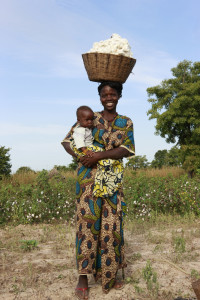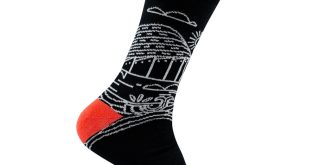
Cotton is the world’s oldest commercial crop and one of the most important fibre crops in the global textile industry. EMMA REINHOLD, trade relations manager, Soil Association Certification, answered some questions on organic cotton.
Q. What is the Cotton On campaign and what are its aims?
A. The Soil Association launched the Cottoned On campaign in collaboration with GOTS (the Global Organic Textile Standard) in 2012 in order to raise awareness of some of the key benefits of organic cotton. We felt that there was a lack of clear and concise information for consumers about the reasons why organic cotton is so beneficial.
Q. What is the definition of organic cotton?
A. Unlike food, textile products don’t have to be certified in order to be described as organic. A product claiming to be organic might only contain a small percentage of organic cotton or may be made of organic cotton but dyed using toxic chemicals which would never be allowed in certified organic products. The use of any organic cotton is a great first step, but in order to be sure a product really is organic from field to finished product, look out for either the Global Organic Textile Standard (GOTS) symbol. Other schemes, such as Textile Exchange’s OE100 ensure that the cotton is grown organically, which is great, but don’t cover how it is processed.
Q. What benefits does organic cotton have for the environment as opposed to other types of cotton?
A. Growing organic cotton has a broad and significant range of environmental benefits. Data produced as part of Defra’s Sustainable Cotton Action Plan showed that on average, organic cotton results in a 32% reduction in greenhouse gas emissions and a 53% reduction in fresh water use when compared with conventionally grown cotton.
A recent Lifecycle Analysis (LCA) of organic cotton found organic uses 91% less water, 62% less energy and has 46% lower global warming potential compared to non-organic, which goes to illustrate what a big difference organic cotton can make.
2.4% of the world’s crop land is planted with cotton, yet it accounts for 24% and 11% of the global sales of insecticide and pesticides respectively. Organic cotton prohibits the use of toxic pesticides.
Also, organic cotton is never genetically modified. GM locks farmers into expensive contracts with GM seed companies, yet regularly fails to deliver on its promises of higher yields. Problems with secondary pests and poor adaptability to climate change are resulting in significant farmer debts and farmers being trapped on a chemical treadmill. Leaving aside the huge environmental and social benefits of organic cotton, studies have shown that organic cotton can be just as profitable (and in some cases more so) than conventionally grown cotton (which is nearly always genetically modified).
Finally, organic cotton also brings a range of social benefits. It helps farmers feed their families as farmers have to grow other crops alongside the cotton which helps provide nutritious sources of food as well as an alternative income for farmers.
Q. For garment manufacturers does organic cotton cost more to buy?
A. Sometimes organic cotton can cost more than conventional cotton, but this is not always the case. As cotton is a major commodity crop, prices can fluctuate.
The trend towards fast and cheap fashion often means someone or something else is paying the price. When it comes to cotton, this can be the farmers – 99% of whom live on the breadline in developing countries, or the environment – degraded and poisoned by pesticides and fertilisers.
The price of organic includes investments made by farmers who are protecting the environment, maintaining soil fertility, preserving biodiversity and conserving water. This means organic cotton sometimes (but not always) is more expensive because the costs aren’t hidden.
Committing to purchase in advance benefits everyone; it secures farmers’ incomes, helps them plan ahead and improve their farming practices, which in turn reduces the price of producing organic cotton, meaning a lower price all round.
Q. How does someone know if their cotton is organic?
A. As cotton doesn’t have to be certified in order to call it ‘organic’, buying truly organic cotton can sometimes be a minefield. You should look for the logo – GOTS and/or Soil Association, which is on all GOTS certified clothing if you want to be sure that clothes have been produced and processed organically.
Q. Is organic cotton good quality?
A. Organic produces great quality cotton. As Mariusz Stochaj from Continental Clothing (a Soil Association licensee) puts it “…when compared like-for-like, organic fibres consistently produce better quality yarns than conventional cotton.”
Q. As far as decoration potential is organic cotton as easy to print and embroider as other cottons?
A. Organic Cotton is no different to non-organic cotton in terms of the ease with which it can be printed on or embroidered. Under GOTS certification the most hazardous and toxic dyeing and finishing processes are banned, so only certain approved dyes and inks can be used.
Q. What is the difference between fair trade and organic cotton?
A. Fairtrade cotton farmers receive a premium price which they can use to cover production costs and fund community development projects, such as drilling wells and building schools. Some Fairtrade farmers still use pesticides (although only from a restricted list), but 19% of all Fairtrade cotton is also organically produced.
Organic farming recognises that we live in a world which operates as a complex system and that every action has direct and indirect impacts on other people and the environment. Organic cotton farmers aim to minimise negative impacts and promote positive ones. For example, they concentrate on natural ways of building soil fertility to increase productivity, rather than using synthetic chemicals which might cause short term yield increases but have long term impacts on the surrounding environment.
Cotton which is ‘dual certified’ organic and Fairtrade is considered the ‘gold standard’ for sustainable cotton.
 Printwear & Promotion The Total Promotional Package
Printwear & Promotion The Total Promotional Package




